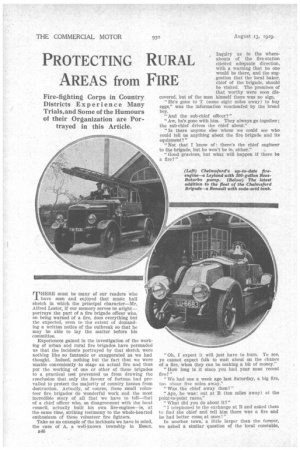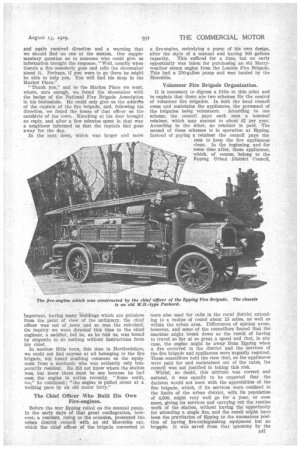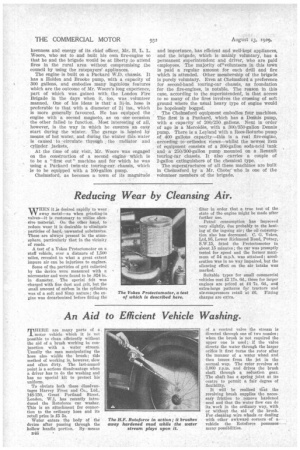PROTECTING RURAL
Page 72

Page 73

Page 74

If you've noticed an error in this article please click here to report it so we can fix it.
AREAS from FIRE
THERE must be many of our readers who _L have seen and enjoyed that music hall sketch in which the principal character—Mr. Alfred Lester, if our memory serves us aright— portrays the part of a fire brigade officer who, on being warned of a .fire, does everything but the expected, even to the extent of demanding a written notice of the outbreak so that he may be able to lay the matter before his committee.
Experiences gained in the investigation of the working of urban and rural fire brigades have persuaded us that the incidents portrayed by that sketch were nothing like so fantastic or exaggerated as we had thought. Indeed, nothing but the fact that we were unable conveniently to stage an actual fire and thus put the working of one or other of these brigades to a practical test prevented us from drawing the conclusion that only the favour of fortune had prevailed to protect the majority of country houses from destruction. Actually, of course, these small volunteer fire brigades do wonderful work and the most incredible story of all that we have to tell—that of a chief officer who, on disagreement with the local council, actually built his own fire-engines—is, at the same time, striking testimony to the whole-hearted enthusiasm of these volunteer fire fighters.
Take as an example of the incidents we have in mind, the case of A, a well-known township in Essex. B46 Inquiry as to the whereabouts of the fire-station clicked adequate direction, with a warning that no one would be there, and the suggestion that the local baker, chief of the brigade, should be visited. The premises of that worthy were soon discovered, but of the man himself there was no sign.
"He's gone to T (some eight miles away) to buy eggs," was the information vouchsafed by the bread boy.
" And the sub-chief officer?"
" Aw, he's gone with him. They always go together; the sub-chief drives the chief about."
"Is there anyone else whom we could see who could tell us anything about the fire brigade and its equipment?"
" Not that I know of : there's the chief engineer to the brigade, but he won't be in, either."
"Good gracious, but what will happen if there be a fire?"
"Oh, I expect it will just have to burn. Ye see, ye cannot expect folk to wait about on the chance of a fire, when they can be making a bit of money." "how long is it since you had your most recent fire?"
"We had one a week ago last Saturday, a big fire, too about five miles away."
"Was the chief away then?"
"Aye, he was : out at B (ten miles away) at the point-to-point races."
"What did you do about it?" " I telephoned to the exchange at B and asked them to find the chief and tell him there was a fire and he had better come at once " In another town, a little larger than the former, we asked a similar question of the local constable, and again received direction and a warning that we should find no one at the station. Our supplementary question as to someone who could give us information brought the response, "Well, usually when there's a fire somebody goes and tells the shoemaker about it. Perhaps, if you were to go there he might be able to help you. You will find his shop in the Market Place."
"Thank you," and to the Market Place we went, where, sure enough, we found the shoemaker with the badge of the National Fire Brigade Association in his buttonhole. He could only give us the addreNs of the captain of the fire brigade, and, following his direction, we found the house of that officer on the outskirts of the town. Knocking at his door brought no reply, and after a few minutes spent in that way a neighbour informed us that the captain hk.c1 gone away for the day.
In the next town, which was larger and more Important, having many lbuildings which are priceless from the point of view of the antiquary, the chief officer was out of town and so was the sub-chief. On inquiry we were directed this time to the chief engineer, a saddler, but he, as he told us, was bound by etiquette to do nothing without instructions from his chief.
In another little town, this time in Hertfordshire, we could not find anyone at all belonging to the fire brigade, but heard scathing comment on the equipment from a mechanic who was evidently only temporarily resident. He did not know where the station was, but knew there must be one because he had seen the engine in action recently. "Some outfit, too," he continued; "the engine is pulled about at a walking pace by an old motor lorry."
The Chief Officer Who Built His Own Fire-engines.
Before the war Epping relied on the manual pump. In the early days of that great conflagration, however, a resident, rising to the occasion, presented the urban district council with an old Mercedes car, which the chief officer of the brigade converted to a fire-engine, embodying a pump of his own design, after the style of a manual and having 100 gallons capacity. This sufficed for a time, but an early opportunity was taken for purchasing an old Merryweather steam engine from the London Fire Brigade. This had a 250-gallon pump and was hauled by the Mercedes.
Volunteer Fire Brigade Organization.
It is necessary to digress a little at this point and to explain that there are two schemes for the control of volunteer fire brigades. In bath the local council owns and maintains the appliances, the personnel of the brigades being volunteers. According to one scheme, the council pays each man a nominal retainer, which may amount to about £2 per year. According to the other, no retainer is paid. The second of these schemes is in operation at Epping. Instead of paying a retainer the council pays the men to keep the fire appliances clean. In the beginning, and for some time after, these appliances, which, of course, belong to the Epping Urban District Council, were also used for calls in the rural district extending to a radius of round about 15 miles, as well as within the urban area. Differences of opinion arose, however, and some of the cOuncillors feared that the machine might break down as the result of having to travel so far at so great a speed and that, in any case, the engine might be away from Epping when a fire occurred in the district and the services of the fire brigade and appliances were urgently required. These councillors held the view that, as the appliances were paid for and maintained out of the rates, the council was not justified in taking this risk.
Whilst, no doubt, this attitude was correct and natural, it was equally to be expected that the decision would not meet with the approbation of the fire brigade, which, if its services were confined to the limits of the urban district, with its population of 4,000, might very well go for a year, or even more, giving its services and carrying out the routine work of the station, without having the opportunity for attending a single fire, and the result might have been the gravitation of Epping to the anomalous position of having fire-extinguishing equipment but no brigade. It was saved from that ignominy by the keenness and energy of its chief officer, Mr.. H. L. L. Woore, who set to and built his own fire-engine so that he and the brigade would be at liberty to attend Sires in the rural area without compromising the council by using the ratepayers' appliances.
The engine is built on a Packard W.D. chassis. It has a Holden and Brooke pump, with a capacity of 300 gallons, and embodies many ingenious features which are the outcome of Mr. Woore's long experience, part of which was gained with the London Fire Brigade in the days when it, too, was volunteer manned. One of his ideas is that a 31-in, hose is preferable to that with a diameter of 2i ins., which is more generally favoured. He has equipped the engine with a second magneto, as on one occasion the other failed to function. Most interesting of all, however, is the way in which he ensures an easy start during the winter. The garage is hearted by means of hot water, and during the winter this water is caused to --circulate through the radiator and cylinder jackets,
At the time of our visit, Mr. Woore was engaged on the construction of a second engine which is to be a "first out" machine and for which he was using a Packard twin-six touring-car chassis, which is to be equipped with a 100-gallon pump.
Chelmsford, as becomes a town of its magnitude and importance, has efficient and well-kept appliances, and the brigade, which is mainly voluntary, has a permanent superintendent and driver, who are paid employees. The majority of' volunteers in this town is paid a regular amount for each drill and fire which is attended. Other membership of the brigade is purely voluntary. Even at Chelmsford a preference for second-hand touring-car chassis, as foundation for the fire-engines, is notable. The reason in this case, according to the superintendent, is that access to so many of the fires involves the crossing of soft ground where the usual heavy type of engine would be hopelessly bogged.
The Chelumford equipment embodies four machines. The first is a Panhard, which has a Dennis pump, with a capacity of 200/250 gallons. Next in order of age is a Mercedes, with a 300/350-gallon Dennis pump. There is a Leyland with a Rees-Roturbo pump of 400 gallons capacity—this is a real fire-engine, according to orthodox views—whilst the newest item of equipment consists of a 300-gallon soda-acid tank and a 250/300-gallon pump mounted on a Renault touring-car chassis. It also carries a couple of 2-gallon extinguishers of the chemical type.
The superstructures of all these machines are built in Chelmsford by a Mr. Chote; who is one of the volunteer members of the brigade.




















































































































